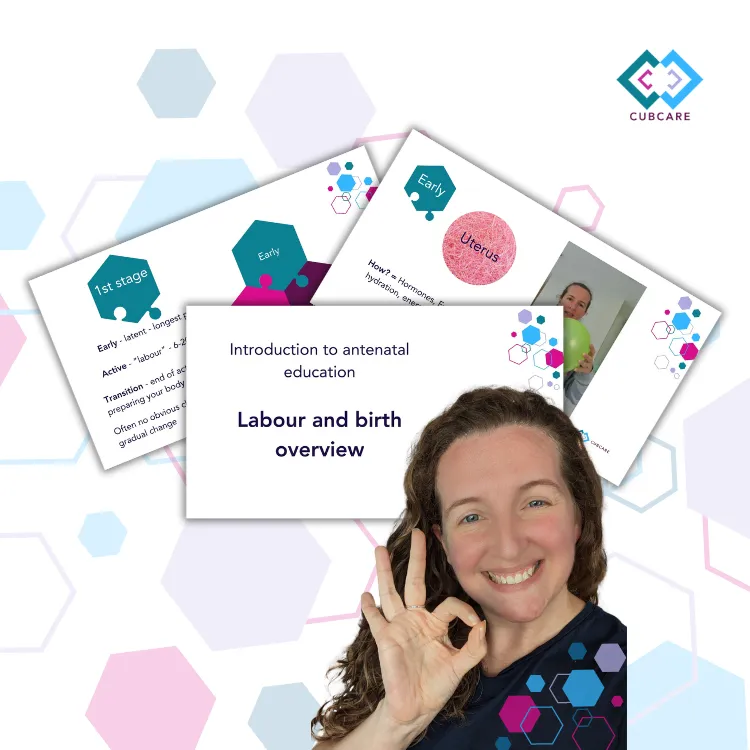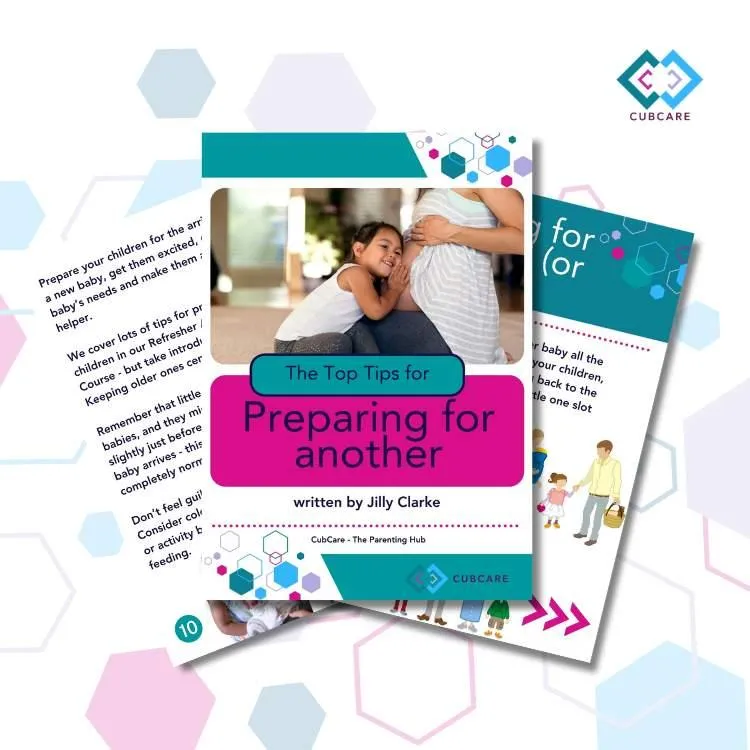We're an award winning Antenatal and Postnatal Education Platform 2025!
(read more here)
CubCare blogs.
From early pregnancy to newborn development.
Advice to help through pregnancy, birth and childhood.
BLOG

Why is breathing good for birth?
"Slow controlled breathing in labour can bring down your heart rate and bring a sense of calm. It will reduce adrenaline, release oxytocin into your body and provide an overall feeling of relaxation." - Jilly Clarke
Why is breathing so important in labour?
Have you ever experienced a stressful situation and had a “helpful” person telling you to “breathe”. It isn’t exactly helpful is it?
Now imagine all those films and television programmes you have seen where somebody is in labour. There is almost always someone standing there, panicking, telling the person to breathe. It's quite clear they could use their own advice and do some controlled breathing.
Because, breathing in a slow, controlled manner does a lot of good in our body. Particularly when it comes to pregnancy and birth.
Slow breathing can bring down your heart rate and bring a sense of calm. It will reduce adrenaline, release oxytocin into your body and provide an overall feeling of relaxation. The edges of the world blurs, and the happy, calm feelings take over.
Combine this with increased oxygen for our muscles, helping the muscle fibres of the uterus to do their job as efficiently as possible - and you've got a powerful recipe for improving labour..
There is a technique to breathing effectively though. It is not just the normal day to day breathing in and breathing out.
We tend to breathe mainly just to our chest and not taking big deep breaths into our tummies, our sides, our backs, really filling up our lungs. That means that we're not filling our lungs fully, not taking efficient breaths. We may tend to breathe quicker and shallower than is ideal to get oxygen in, but mainly we’re not getting all the benefits of breathing that we could possibly do.

Why is breathing good for birth?
Slow breathing can bring down your heart rate and bring a sense of calm. It will reduce adrenaline, release oxytocin into your body and provide an overall feeling of relaxation.
A recent study published in 2023 discovered a link between breathing exercises and a short duration of labour. It also reported a 45% decrease in C-sections, and an improved perception of pain and anxiety.
When you breathe calmly and slowly during labour, it will help you relax and release tension, can reduce pain and alleviate fears. Even better if you are able to practice the technique regularly during pregnancy it can allow your body to feel more familiar with it. Building our muscle memory by regular practice can really make things come easier when we do need them.

How do you breathe in labour?
Early labour is the best time to start using a calm, slow, deliberate breathing pattern. Practicing in pregnancy will mean that when the time comes and you need some extra support of breathing during contractions, the technique will come easily to you.
If you can, breathe in through your nose and out through your mouth. Keeping your jaw relaxed and exhaling for twice as long as you inhale. We like to try to breathe in for a count of 4 and breathe out for a count of 8. The exhale is the important bit. Especially through a soft relaxed jaw.
The exhale is the bit that takes the tension away, that releases all the stress; and it is the bit that helps to physically relax your body.
Breathe.
As.
Slowly.
As.
Possible.
Notice how that feels. Close your eyes and breathe like that for 5 or 6 breaths and notice how your body responds.
Slow breathing signals to your nervous system that everything is safe, that there is no danger. This in turn reduces adrenaline in your body, helps you feel calmer, more relaxed.
And for labour it will help direct oxygen to your uterus instead of your arms, legs and brain in order to fight the "threat".
We hold so much tension in our jaws, it is generally the strongest muscle in our body (besides the uterus!). Notice how when your jaw is tense, your shoulders are tense, your core is tense, your pelvis is tense too. It is all connected. Release the jaw and everything else has a chance to release too.
As your labour progresses, the oxygen requirements of your uterus and the rest of your body increases. We have a second breath that pumps more oxygen into the body, helps you to stay a step ahead and feel in control of the contraction and helps you to relax. We also want to ensure our stomach muscles don't get too involved whilst the contractions are at the peak, otherwise the uterus could be restricted, making contractions less efficient.
We call is The Climb Breath and you can learn it in any of our Antenatal courses. You want to have as many techniques as possible to call upon in labour if you need it.
How to practice breathing for labour?
A few times a day take some time out to check-in with your body. Close your eyes if you feel comfortable, relax your face, shoulders, tummy muscles and focus on your breath. Take your time to take deeper and deeper breaths - sometimes our diaphragm (especially when pregnant and restricted!) can have a hard time finding the full range of movement that it needs to really fill our lungs. So taking some time to gently encourage the range of movement can help.
Take the slow in for 4, out for 8 breaths for at least 10 rounds at a time. There is no upper limit, but at least 10 breaths will let you fully relax and feel the benefits.
The more you practice, the quicker your body recognises the technique and falls into a relaxed state.
So practice it for 10 rounds, two or three times a day if possible.
Tension isn't our friend in pregnancy or during labour.
For labour, for birth, and for general day to day life. Tension will cause our muscles to contract, to be ready for “fight or flight”. It can heighten our sensation of pain and prevent your body from opening and moving. And childbirth is all about opening and moving! The cervix needs to move and change around baby’s head and we need to feel open, trusting and receptive to what’s going on with our bodies in order for labour to progress. To release tension, you need to consciously relax your body.
When you breathe during labour, focus on that slow breathing, that in for 4 and out for 8. It will help you relax and release tension and can reduce pain and alleviate fears. Even better if you are able to practice the technique regularly during pregnancy it can allow your body to feel more familiar with it. Building our muscle memory by regular practice can really make things come easier when we do need them.
Remember, our bodies are SO capable. With the trust, the knowledge and the education you CAN have an amazing birth experience.
That's why we have our Antenatal Course (both in person and online), Refresher Antenatal Course (both in person and online), and our Birth Partner course so that everybody can get knowledgeable and confident for birth.
Refresher Antenatal Course in person
Refresher Antenatal Course online
Birth Partner course (included in our Antenatal course)
Antenatal Course in person
Antenatal Course online
Easily navigate to our most popular Blog categories
Download our Freebies

Labour and Birth
Watch our introduction to antenatal education webinar, our labour and birth overview - to start your antenatal education journey. Understanding the process, and what you can do to influence it.

Pregnancy Planner
Free Pregnancy Planner to help you prepare for a little one. Prepare your body, your mind, your finances and your home. Get organised, feel good and prepare for an active, positive birth.

Birth Partner Guide
Your ultimate guide to being the best birth partner during pregnancy, birth and recovery. Learn what you need to do, and what you need to learn to be the best birth partner possible.

Expecting Again Guide
Your ultimate guide to preparing for another birth and an extra baby. Our top tips for navigating pregnancy and birth, and helping your older ones to transition into their new role as a big sibling.
Based in Welwyn Hatfield, offering local pregnancy support and doula services across Hertfordshire: St Albans, Hatfield, Welwyn Garden City, Potters Bar, Stevenage, Harpenden, Hitchin, Barnet, Mill Hill and surrounding areas.
Online antenatal and postnatal education available UK-wide.
© Copyright 2025 CubCare The Parenting Hub. CubCare is operated by The Birth and Baby Company Ltd. Company No. 15655287
Privacy Policy | Terms & Conditions | Medical Disclaimer | Inclusivity and Accessibility

